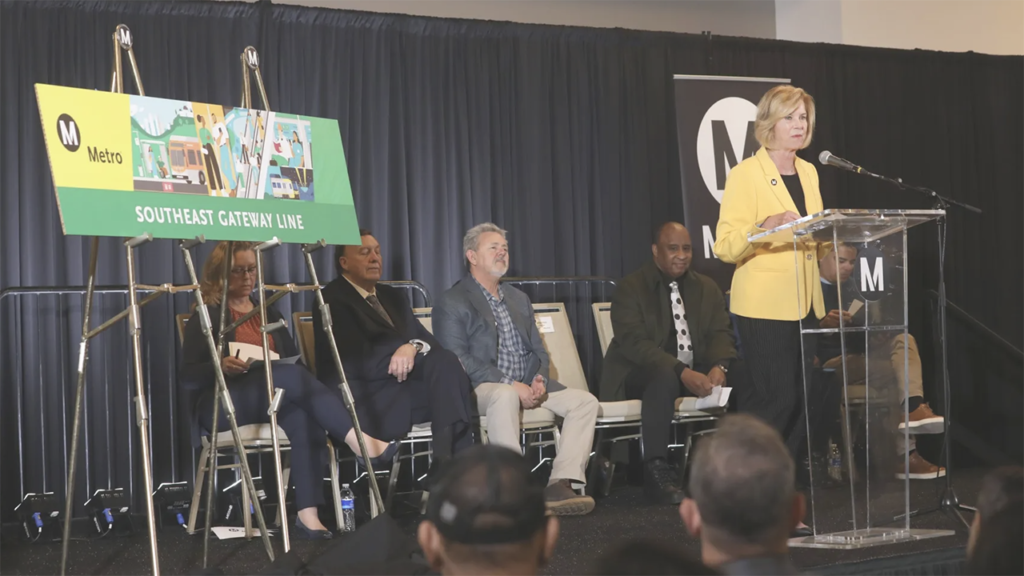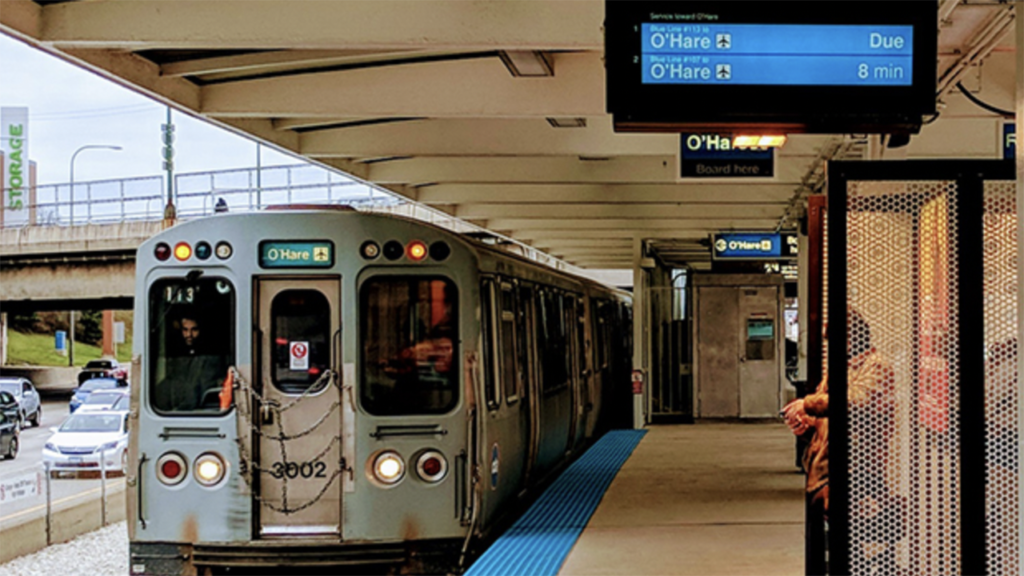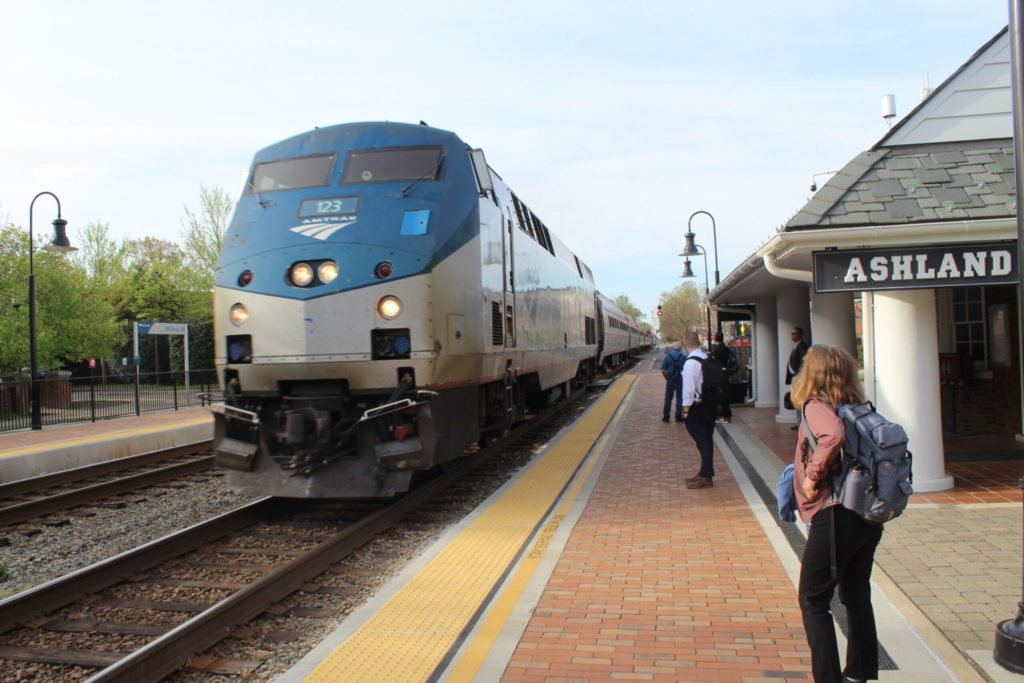
Transit Briefs: Bay Area Transit, LACMTA, CTA, Amtrak Virginia
Written by Marybeth Luczak, Executive Editor
San Francisco Bay Area transit in California will take on a whole new look later this year. Transit agency and Metropolitan Transportation Commission officials unveiled design prototypes for a common set of signs to be used by all agencies at all locations. (Image Courtesy of BART)
A project is under way to unify San Francisco Bay Area transit maps and signs. Also, Los Angeles County Metropolitan Transportation Authority (LACMTA) renames the West Santa Ana Branch Corridor Project to avoid rider confusion; and Chicago Transit Authority (CTA) and Amtrak Virginia set ridership records in 2023.
Metropolitan Transportation Commission (MTC) / Bay Area Transit Agencies
The ongoing work of San Francisco Bay Area transit agencies to provide a more connected, efficient and customer-focused “mobility network” has taken step forward as agency and MTC members of the Regional Network Management Council unveiled design prototypes for a common set of signs to be used by all agencies at all locations—from individual bus stops to major hubs where multiple systems connect, according to MTC, the transportation planning, financing and coordinating agency for the nine-county Bay Area. These prototypes will be installed later this year at the El Cerrito del Norte BART station, the Santa Rosa Transit Mall, and the nearby Santa Rosa SMART (Sonoma-Marin Area Rail Transit) station. The Council includes executives from MTC; San Francisco Bay Area Rapid Transit District (BART); San Francisco Municipal Transportation Agency; AC Transit; Santa Clara Valley Transportation Authority; Caltrain; SamTrans; Golden Gate Bridge, Highway and Transportation District; and three general managers representing all other transit agencies serving Bay Area communities.
“To establish and reinforce a common identity for all Bay Area transit services, the new signage employs a three-color palette of golden yellow, sky blue, and dark blue, as well as simple icons to identify service by trains, buses or ferries,” MTC said. “These icons are larger and more visually prominent than the logos of the individual agencies providing the services at each location. The modal icons and the three-color palette will be extended to a new mobile-friendly website to which passengers can connect via QR codes at each bus stop, train station or ferry terminal, providing real-time information along with accessibility features such as audio descriptions and language translation.”
In 2021, MTC polled Bay Area residents and more than 90% of them identified uniform and easy-to-use transit maps and signage “as an important priority for improving the region’s transit network,” it said. In 2022, MTC’s Operations Committee approved a contract with Applied Wayfinding Inc. to develop a single mapping and wayfinding system for use by all Bay Area transit agencies. The company has completed similar projects in London; Toronto; Seattle; Cleveland; and Vancouver, B.C. According to MTC, the design concepts incorporate comments and recommendations from more than 1,000 residents—including transit riders and nonriders, people with limited English proficiency, and people with disabilities—who participated in MTC-sponsored surveys, workshops and focus groups. MTC said the new transit signage will include tactile and Braille elements.
The golden yellow in the three-color palette developed by transit agencies, MTC and the design contractor was selected to represent “the Bay Area’s sunshine and golden hills; with the light blue representing clear skies; and the dark blue representing San Francisco Bay, lakes, rivers and other bodies of water,” according to MTC. It noted that residents and visitors will be invited to share their thoughts about the newly designed transit signs and digital wayfinding tools once the prototypes—which have not yet been fabricated—are installed at the Santa Rosa and El Cerrito locations.
Design prototypes for a consistent set of transit maps will be unveiled later this year, BART reported.
LACMTA

LACMTA, in partnership with LA County Supervisor and First Vice Chair of the LACMTA Board Janice Hahn, launched a contest last August to rename the 14.5-mile light rail project that will run between Vernon and Artesia and connect southeast Los Angeles County. Originally called the West Santa Ana Branch Corridor Project—named for the former Pacific Electric right-of-way—the rail line will not extend all the way to Santa Ana and was causing confusion, according to LACMTA.
The transit authority received more than 1,200 name suggestions, and in November, shortlisted 12 and asked riders to vote for their favorite one. The votes are in—more than 1,000 of them—and the winning name is Southeast Gateway Line, LACMTA reported Jan. 22.
This name was submitted by multiple people, said the transit authority, which speculated that it resonated because of “the access and opportunities that the light rail line will bring to the 1.4 million-plus people who inhabit the Gateway communities (South Gate, Huntington Park, Bellflower, Paramount, and many more).”
This name will define the project until it opens to the public, which is expected in 2035. At that time, the Southeast Gateway Line will get an official line letter and color.
In January 2022, the LACMTA Board of Directors approved the Locally Preferred Alternative (LPA) and a Maintenance and Storage Facility for the line (see map below). The LPA will advance as part of the analysis in the Final Environmental Impact Statement/Environmental Impact Report, expected for LACMTA Board certification this year.

The Board also selected Los Angeles Union Station (LAUS) as the northern terminus for the line. Staff are conducting a separate study to evaluate options for connecting from Slauson/A Line to Union Station, according to LACMTA. The next step of the study includes preparing the Draft report, additional stakeholder engagement, and presenting study findings to the LACMTA Board in 2024.
Preparation of a First/Last Mile (FLM) Plan is under way. The project team completed existing conditions analysis and community engagement in fall 2023 and will bring a final FLM plan to the Board for adoption concurrent with the final environmental document for the rail project, according to LACMTA.
CTA

CTA provided 279 million train and bus rides in 2023, “a year marked by steady growth in ridership and more reliable service,” the transit authority reported Jan. 22. The increase was just over 14% year-over-year.
Systemwide in 2023, CTA provided nearly 36 million more rides compared with 2022, it said. Rail ridership grew 13.4% over 2022 and bus ridership increased 15.5%. Over the course of the year, CTA said it experienced 27 days when ridership exceeded one million rides per day.
Like transit systems across the country, CTA said it has seen consistent ridership growth since the start of the pandemic. Its ridership dropped to around 20% in April 2020 and has gradually risen to just over 60% of pre-pandemic ridership.
“Last year we experienced significant post-pandemic improvement and saw very good trends that we hope will continue, year-over-year, in 2024,” CTA President Dorval R. Carter Jr. said. “As we look toward meeting the ridership demands of this year—particularly on rail—we have set an aggressive goal of training 200 rail operators in 2024.”
Amtrak Virginia

The Virginia Passenger Rail Authority (VPRA) on Jan. 22 reported that more than 1.32 million passengers traveled on its state-supported Amtrak Virginia service during calendar year 2023. This was the highest ridership recorded since state-supported service began in 2009, and the total—1,325,937—beat calendar year 2022 ridership by 29.8%, VPRA said.
All four Amtrak Virginia corridors saw increases year-over-year with Newport News leading the way with a 36.8% increase over 2022. The month of August set a record for monthly ridership with 130,998 passengers traveling.
VPRA noted that calendar year 2023 ridership included eight daily roundtrips. Ridership for the first half of calendar year 2022 included five daily roundtrips as three were added in July 2022—one to Roanoke and one to Norfolk, and the third, to Newport News, was the resumption of service cancelled due to the pandemic.
“Virginians continue to tell us that they want passenger rail to lighten the load on the state’s highways and to provide them with an alternative to sitting in traffic,” VPRA Executive Director DJ Stadtler said. “And, we are listening. With recent grant funding and the selection of construction partners, the team at VPRA is pushing our Transforming Rail in Virginia initiative to the next level to provide additional passenger rail service in the commonwealth as soon as possible.”
VPRA has purchased railroad right-of-way and is building infrastructure through its Transforming Rail in Virginia initiative. Last fall, it was awarded two grants to fully fund projects in Northern Virginia. The Franconia-Springfield Bypass received a $100 million CRISI grant from the Federal Railroad Administration (FRA). VPRA was also awarded a $729 million grant through the FRA’s Federal-State Partnership for Intercity Passenger Rail Program for the completion of Phase 2 of the Transforming Rail in Virginia initiative. VPRA said these investments will help it complete the final design and construction of Long Bridge and all Phase 2 projects, which will relieve rail congestion that affects service throughout the commonwealth and along the East Coast. VPRA in December reported selecting Skanska/Flatiron Joint Venture for the Long Bridge-North Package and Flatiron/Herzog Joint Venture for the Franconia-Springfield Bypass.
Amtrak Virginia currently offers three daily roundtrips between Norfolk and Washington, D.C.; two daily roundtrips between both Roanoke and Washington, and Newport News and Washington; and one daily roundtrip between Richmond and Washington. Completion of the Transforming Rail in Virginia initiative’s Phase 2 projects will allow for three new roundtrips. Those will be in addition to the current eight roundtrips and the two that are scheduled to launch upon completion of Phase 1 projects in 2026 for a total of 13 daily roundtrips by 2030, according to VPRA.



